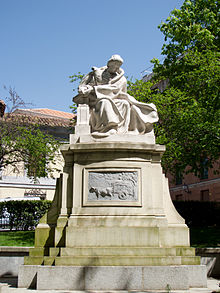 | |
| 40°25′35″N 3°42′46″W / 40.42631°N 3.712841°W / 40.42631; -3.712841 | |
| Location | Calle de la Princesa, Madrid, Spain |
|---|---|
| Designer | Rafael Vela [es] (statue) Pedro Muguruza (plinth) |
| Material | Limestone, marble, granite |
| Opening date | 24 June 1926 |
| Dedicated to | Emilia Pardo Bazán |
The Statue of Emilia Pardo Bazán is an instance of public art in Madrid, Spain. Located next to the calle de la Princesa, it is dedicated to Emilia Pardo Bazán.
History and description
Following the death of Pardo Bazán in 1921, the first to come up with the idea of an homage to Pardo Bazán in Madrid was Eugenio Rodríguez Ruiz de la Escalera [es]. The costs were funded—under the auspice of María del Rosario de Silva, the Duchess of Alba—via popular subscription from women from Spain and Argentina.
The statue—made of limestone and representing Pardo Bazán—was a work by Rafael Vela del Castillo [es], while the plinth was authored by Pedro Muguruza.
Erected next to the Palacio de Liria and close to Pardo Bazán's Madrilenian address at the calle de la Princesa, the monument was unveiled on 24 June 1926. The ceremony of inauguration was presided by King Alfonso XIII and Victoria Eugenie. Romanones, Blanca de Igual y Martínez Dabán (viscountess of Llanteno and Madrid municipal councillor) and Eduardo Callejo de la Cuesta (Minister of Public Instruction), intervened as speakers.
In March 2019, the district junta of Centro voted to name the surrounding gardens as Jardines de las Feministas ("Gardens of the Feminists").
References
- Citations
- ^ Montero Padilla 2006.
- ^ Mora 2019, p. 68.
- Moral Roncal 2015, pp. 5352, 5362.
- "El monumento a Doña Emilia Pardo Bazán". La Nación. II (214). Madrid: 5. 24 June 1926. ISSN 1132-046X.
- "Los «Jardines de las Feministas» rodearán la estatua de Emilia Pardo Bazán". Somos Malasaña. El Periódico. 21 March 2019.
- Bibliography
- Montero Padilla, José (14 June 2006). "Emilia Pardo Bazán en su estatua". El Rinconete. Madrid: Centro Virtual Cervantes. ISSN 1885-5008.
- Mora, Gloria (2019). "'Como en las cavernas'. Primitivismo y progreso en los cuentos de épocas pasadas de Emilia Pardo Bazán". Veleia (36). Bilbao: Universidad del País Vasco/Euskal Herriko Unibertsitatea: 57–71. doi:10.1387/veleia.20830. hdl:10810/39774. ISSN 0213-2095.
- Moral Roncal, Antonio Manuel (2015). "El elemento nobiliario en la redefinición urbana: el caso de la Villa y Corte (1835-1931)". Pensar con la Historia desde el siglo XXI: XII Congreso de la Asociación de Historia Contemporánea. Madrid: UAM Ediciones. pp. 5347–5381. ISBN 978-84-8344-458-0.